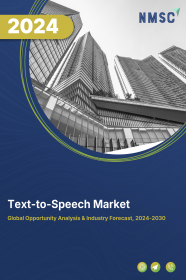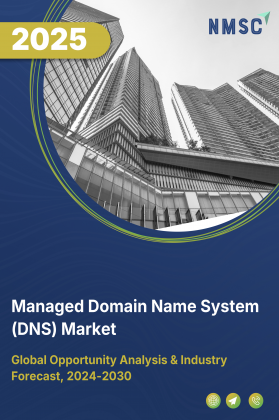
Text-to-Speech Market by Component (Software and Services), by Deployment (Cloud-Based and On-Premise), by Voice Type (Neural & Custom and Non-Neural), by Organization Size (SMEs and Large Enterprise), and by End-User (BFSI, IT and Telecommunications, Government, Consumer Goods & Retail, Healthcare, Manufacturing, and Others) – Global Opportunity Analysis and Industry Forecast, 2024–2030
Text-to-Speech Market Overview
The global Text-to-Speech Market size was valued at USD 3.24 billion in 2023 and is predicted to reach USD 8.80 billion by 2030 with a CAGR of 15.3% from 2024-2030. The Text-To-Speech industry involves the development, production, and distribution of software and hardware solutions that convert written text into spoken voice output. This industry includes cloud-based services, embedded systems, applications, APIs, and dedicated or integrated hardware devices. Key components of TTS solutions are synthetic voice quality, customization options, and multilingual support.
The industry serves individual consumers, businesses, and public sector entities across various fields such as healthcare, automotive, media, and education. These solutions also increase productivity by enabling faster consumption of information through audio output, aiding multitasking and hands-free operation. In conclusion, the Text-to-Speech industry offers a range of benefits including improved accessibility, efficiency, personalization, and scalability, making it a valuable tool for individuals, businesses, and organizations across diverse sectors.
Market Dynamics and Trends
The growing demand for text-to-speech technology in the automotive sector, used for spoken directions to enhance the convenience and safety of drivers, fuels market growth. This technology has been used in messaging and reading news to enable drivers to get information without diverting their attention from the road.
For example, in August 2023, Boson Motors collaborated with Cerence to enhance the in-vehicle experience across its wide range of electric trucks. This partnership offers TTS technology to Boson's vehicles, further incorporating intelligence and personality into the driving experience.
Moreover, the growing adoption of text-to-speech technology in healthcare industries to enhance better patient communications and engagement for those patients who have speech or visual disability has strengthened the text-to-speech market growth worldwide.
This technology is facilitating assistive devices, telemedicine, and remote healthcare by making transparent and virtual consultations with distant doctors. For example, VidaTalk, a top healthcare communication platform, introduced a new "Unsilence Healthcare" campaign in April 2024, which will help break down the language barrier and increase access to interpreter services.
However, high cost and complexity associated with integrating TTS technologies is further hindering the overall market growth. On the contrary, the incorporation of neural networks into TTS technology is driving a significant improvement in the quality and applicability of synthesized speech which creates new opportunities for innovation and market growth.
For instance, in April 2022, Google Cloud developed its new models for its text-to-speech API, which will improve accuracy across 23 languages and 61 locales. The new models are based on a neural sequence-to-sequence model for speech recognition, leveraging cutting-edge machine learning techniques to better utilize speech training data and achieve optimized results.
Market Segmentations and Scope of the Study
Text-to-speech market report is segmented on the basis of component, deployment, voice type, organization size, end-user, and region. Based on components, the market is divided into software and services. Based on deployment, the market is segmented by cloud-based and on-premise. On the basis of voice type, the market is classified into neural & custom and non-neural. On the basis of organization size, the market is fragmented into SMEs and large enterprises. Based on end-users, the market is further segmented into BFSI, IT and telecommunications, government, consumer goods and retail, healthcare, manufacturing, and others. Regional breakdown and analysis of each of the aforesaid segments includes regions comprising of North America, Europe, Asia-Pacific, and RoW.
Geographical Analysis
North-America dominates the text-to-speech market share during the forecast period. This is attributed to factors such as the rising advancements in AI, machine learning, and natural language processing (NLP) technologies towards TTS technology which is further driving the growth of the market.
For example, in February 2023, Duolingo, the popular language-learning platform, increased its learning and user experience using artificial intelligence by turning to Amazon Polly for text-to-speech solutions. The case from the platform demonstrates their use of TTS in language learning, striving to improve pronunciation accuracy and continuous improvement with new technologies in courses.
Additionally, the popularity of audiobooks on websites including Spotify and Audible has greatly affected the growth of the market in North America. These platforms use a TTS system to transform text-based data into audio files, which is actually tailored towards meeting surging need for audiobooks in America. For instance, in September 2022, Spotify added audiobooks to the platform to increase its audio offerings beyond music and podcasts.
This strategic move opens access to a library of over 300,000 titles. The new demand for TTS software and services that appeared in the American market due to the appearance of audiobooks helped convert text-based content into audio. On the other hand, the Asia-Pacific region is witnessing the fastest growth in the Text-to-Speech market trends, driven by technological and digital advancements in the automotive sector.
As the region's population grows and consumers become increasingly tech-savvy, there is a rising demand for innovative voice-based interfaces in vehicles. For instance, in January 2022, Xpeng, an electric vehicle maker, made its electric vehicle (EV) voice assistant more advanced by incorporating Microsoft’s text-to-speech (TTS) feature.
This enhancement is expected to develop a more sophisticated and realistic voice command interface for the user since the demand and incorporation of TTS solutions in industries such as automotive remains high as an aspect of the increasing development of TTS market in that region. Also, a rise in the development of interactive automatic speech response system embedded with artificial intelligence is also contributing to the more expansion of this market in this region.
For instance, in August 2022, Kyndryl has collaborated with JCB Co., Ltd. to introduce an AI based call center information processing automatic speech response system in its call center in Japan. The new system utilizes ASR (Automatic Speech Recognition), TTS (Text-to-Speech), and NLP (Natural Language Processing) technologies that analyze a customer’s words or phrases with AI and then either answer the customer or directly connect him/her to the corresponding operator.
Competitive Landscape
The text-to-speech (TTS) industry comprises various market key players such as Nuance Communication, Microsoft Corporation, IBM Corporation, Google, Inc., Sensory Inc., Amazon.Com, Readspeaker, LumenVox LLC, Acapela Group, CereProc, and others. These market players are adopting various strategies such as product launches to maintain their dominance in the global market.
Also, in January 2023, Microsoft launched the VALL-E, a novel text-to-speech model which replicate voice after just 3 seconds of audio. This technology leverages neural networks and end-to-end modeling to achieve high-quality personalized speech synthesis without additional engineering or fine-tuning.
Moreover, in January 2023, Amazon Polly, a text-to-speech service launched two new neural Text-to-Speech (NTTS) voices for US English namely Ruth, a female voice, and Stephen, a male voice. These new additions expand Amazon Polly's US English voice portfolio to 6 female and 4 male voices, providing customers with a wider range of voice options.
Key Benefits
-
The report provides quantitative analysis and estimations of the text-to-speech market from 2024 to 2030, which assists in identifying the prevailing market opportunities.
-
The study comprises a deep dive analysis of the current and future text-to-speech market trends to depict prevalent investment pockets in the market.
-
Information related to key drivers, restraints, and opportunities and their impact on the text-to-speech industry is provided in the report.
-
Competitive analysis of the key players, along with their market share is provided in the report.
-
SWOT analysis and Porters Five Forces model is elaborated in the study.
-
Value chain analysis in the market study provides a clear picture of roles of stakeholders.
Text-To-Speech Market Key Segments
By Component
-
Software
-
Service
By Deployment Mode
-
Cloud-based
-
On-premises
By Voice Type
-
Neural & Custom
-
Non-neural
By Organization Size
-
SMEs
-
Large Enterprise
By End User
-
BFSI
-
IT and Telecommunications
-
Government
-
Consumer Goods and Retail
-
Healthcare
-
Manufacturing
-
Others
By Region
-
North America
-
The U.S.
-
Canada
-
Mexico
-
-
Europe
-
The UK
-
Germany
-
France
-
Italy
-
Spain
-
Denmark
-
Netherlands
-
Finland
-
Sweden
-
Norway
-
Russia
-
Rest of Europe
-
-
Asia Pacific
-
China
-
Japan
-
India
-
South Korea
-
Australia
-
Indonesia
-
Singapore
-
Taiwan
-
Thailand
-
Rest of Asia Pacific
-
-
RoW
-
Latin America
-
Middle East
-
Africa
-
REPORT SCOPE AND SEGMENTATION:
|
Parameters |
Details |
|
Market Size in 2023 |
USD 3.24 Billion |
|
Revenue Forecast in 2030 |
USD 8.80 Billion |
|
Growth Rate |
CAGR of 15.3% from 2023 to 2030 |
|
Analysis Period |
2023–2030 |
|
Base Year Considered |
2023 |
|
Forecast Period |
2024–2030 |
|
Market Size Estimation |
Billion (USD) |
|
Growth Factors |
|
|
Countries Covered |
28 |
|
Companies Profiled |
10 |
|
Market Share |
Available for 10 companies |
|
Customization Scope |
Free customization (equivalent up to 80 working hours of analysts) after purchase. Addition or alteration to country, regional, and segment scope. |
|
Pricing and Purchase Options |
Avail customized purchase options to meet your exact research needs. |
KEY PLAYERS
-
Nuance Communication
-
Microsoft Corporation
-
IBM Corporation
-
Google, Inc.
-
Sensory Inc.
-
Amazon.Com
-
Readspeaker
-
LumenVox LLC
-
Acapela Group
-
CereProc




















 Speak to Our Analyst
Speak to Our Analyst
























